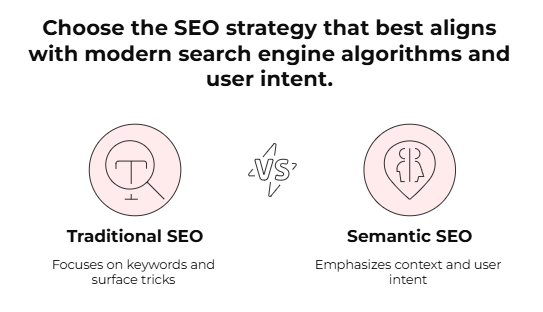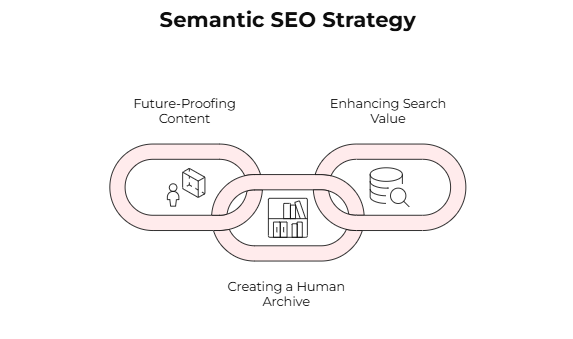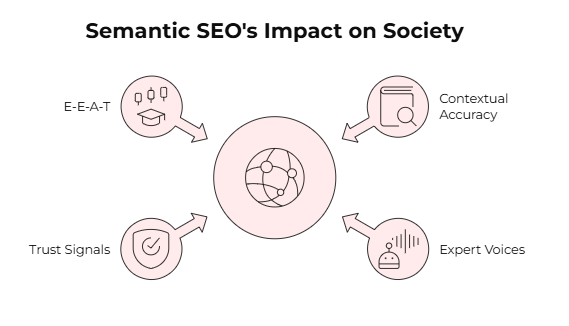What is Semantic SEO? A Future-Proof Guide to Meaningful Search
Introduction: Beyond Keywords
Search engines no longer just match words, they want to understand meaning. This shift is what we call Semantic SEO. Instead of stuffing pages with keywords, Semantic SEO focuses on entities, context, intent, and depth. It is not just about ranking higher today, it is about creating future-proof knowledge archives that remain useful to humans and machines for years to come.
Let us dive in and explore how embracing semantic SEO can elevate your content from fleeting visibility to lasting authority.
What Exactly is Semantic SEO?
From Keywords to Knowledge
Semantic SEO marks a paradigm shift from traditional SEO‘s keyword-centric focus, where it used to rely on exact-match keywords, TF-IDF (Term Frequency-Inverse Document Frequency), and keyword density. Now it is more of a context-centric approach driven by AI and NLP (Natural Language Processing). It is about interpreting the deeper meaning behind queries, powered by algorithms like Google’s Knowledge Graph, Hummingbird, RankBrain, BERT, and generative AI systems such as Search Generative Experience (SGE).

Why the change? Early SEO was like gaming the system with latent semantic indexing (LSI) and surface tricks, but modern search engines prioritize user intent and holistic answers, making semantic SEO the new standard for relevance.
Why Semantic SEO Matters

Imagine planting a garden with shallow roots: it might bloom briefly, but it withers in a storm. Traditional SEO is that fragile plot, vulnerable to algorithm updates. Semantic SEO, however, builds deep, resilient foundations. It resembles a thriving ecosystem. You could invest in keyword stuffing or backlink spam, only to lose rankings overnight. Ouch.
Here is why shifting matters:
- Future-Proofing Your Content: As search engines and AI assistants evolve with machine learning and NLP, they favor meaning over mechanics. Semantic SEO ensures resilience against changes like BERT or MUM, keeping your site visible in AI overviews, featured snippets, and voice search.
- Creating an Archive for Humanity: By weaving entity-rich, context-complete content, you are not just optimizing, you are constructing a referable archive that outlasts trends, serving as a trusted resource for generations.
- High Value in Search: It boosts E-E-A-T (Experience, Expertise, Authoritativeness, Trustworthiness), aligning with rich results, knowledge panels, and conversational search, driving qualified traffic and conversions.
Core Elements of Semantic SEO
1. Entities
An entity is a distinct “thing” with identity: a person, place, brand, product, or concept, forming nodes in Google’s Knowledge Graph. Entity SEO ensures accurate representation, building trust through structured data and Wikidata presence.
Example:
- “Apple” could refer to the fruit or the technology company.
- Semantic SEO aids entity disambiguation by analyzing surrounding terms (e.g., “orchard” vs. “iPhone”), strengthening semantic relationships and topical authority.
2. Context
Search engines assess the surroundings of words, not just the words, using contextual semantic search (CSS) for precision.
Example:
- “Nutritional benefits of apple” signals the fruit via context.
- “Apple stock price today” points to the company. This prevents ambiguity, enhancing applications like e-commerce recommendations or chatbots.
3. User Intent
Semantic SEO matches content to search intent, which is the user’s true goal. They are then categorized into four types:
Example Queries:
- “apple nutrition” → user wants to learn (informational intent).
- “best apple deals” → user wants to buy (transactional intent).
- “apple vs samsung phone” → user wants to compare (commercial intent)
Informational Intent (I): Seeking knowledge (e.g., “apple nutrition”).
Navigational Intent (N): Finding a site (e.g., “Google Structured Data Markup Helper”).
Commercial Investigation Intent (C): Researching options (e.g., “apple vs samsung phone”).
Transactional Intent (T): Ready to act (e.g., “best apple deals”). Aligning with intent satisfies users at every customer journey stage, from awareness to conversion.
4. Content Depth & Coverage
Superficial content fades; depth endures. Semantic SEO demands comprehensive, interlinked content via topic clusters and pillar pages.
Shallow content fades; deep content endures. Semantic SEO thrives on topic completeness.
Example: A semantic SEO-friendly article on “apple fruit” won’t just say “apples are healthy.” It will cover:
- Nutritional value (vitamins, fiber, sugar content)
- Health benefits (heart health, digestion)
- Types of apples (Fuji, Granny Smith, Honeycrisp)
- Recipes (apple pie, apple juice)
- Related entities (orchards, farmers, antioxidants)
By doing this, the article can rank not only for “apple fruit” but also for related queries like:
- “Are apples good for diabetes?”
- “Fiber in apple peel”
- “Fuji vs Granny Smith taste”
Related entities (orchards, farmers, antioxidants). This ranks for core queries plus long-tails like “Are apples good for diabetes?” or “Fiber in apple peel,” creating a knowledge asset that compounds value.
This is how one page becomes an archive, serving multiple audiences over time.
Semantic SEO as a Digital Library
From Keywords to Knowledge
- A historical narrative: early SEO was about tricking algorithms with keywords → now it’s about building knowledge systems.
- This makes the article read like a “journey of search.”
Semantic SEO as a Digital Library
- Every page written well becomes part of a global archive.
- “What Wikipedia is to facts, semantic SEO can be to businesses and niche knowledge.”
Why Semantic SEO is High-Value for Society
- Reduces misinformation by making content contextual.
- Preserves expert voices (e.g., doctors, farmers, engineers) in machine-readable form.
- Makes human knowledge accessible for future generations, not just clicks today.
Think of semantic SEO as curating a global digital library. Each pillar page is a central hub, supported by cluster content on subtopics, linked via internal linking to mirror the Knowledge Graph’s relationships. Unlike ads that vanish, this structure builds domain authority, turning your site into a machine-readable repository like Wikipedia for niches.
Why Semantic SEO is High-Value for Society
Semantic SEO transcends rankings: it combats misinformation through contextual accuracy, preserves expert voices (e.g., doctors on healthcare, farmers on oysters), and makes knowledge accessible. By focusing on trust signals and E-E-A-T, it contributes to the knowledge economy, where businesses document truths for humanity’s benefit.

Practical / Strategic Sections
5. Examples Across Industries
- Apple (fruit vs. company): Disambiguates via context.
- Oysters: Covers safety, farming vs. wild, depuration, linking entities like “Fine de Claire oysters from Marennes-Oléron.”
- Socks: Explores fabrics, breathability, climate suitability.
- Healthcare (IVF): Details treatments, risks, procedures. These make content relatable, boosting engagement.
6. Semantic SEO in Everyday Life
- How it powers “People Also Ask,” voice search, and AI Overviews.
- Readers realize they’re already benefiting from it daily.
It powers People Also Ask, voice assistants (Alexa, Siri, Gemini), and AI overviews, enhancing daily searches.
7. Content as a Knowledge Asset
- Unlike ads that vanish, semantic content compounds over time.
- Acts like a “digital real estate portfolio.”
Unlike short-lived tactics, semantic content acts like digital real estate, growing through entity gap analysis and relationship mapping.
8. Future of Search: AI and Beyond
- Semantic SEO lays the groundwork for AI search, voice assistants, AR glasses, even education bots.
- Your content could one day be cited by an AI tutor teaching a child.
Semantic SEO prepares for AI search engines (Perplexity, You.com), AR glasses, and education bots, ensuring your content is cited in future tools.
9. Semantic SEO as a Cultural Bridge
- Enables multilingual search (concepts remain even if language differs).
- Example: “oyster” in Malay vs. French still maps to the same entity.
It enables multilingual search, mapping concepts across languages (e.g., “oyster” in Malay vs. French).
10. The Responsibility of Content Creators
- Not just to rank, but to document knowledge truthfully.
- A future-proof archive needs trust and accuracy.
Beyond rankings, document knowledge truthfully, and you will start building trust and accuracy for a future-proof archive.
11. From SEO to Knowledge Economy
- Businesses are not just selling, they are contributing to the global knowledge graph.
- This flips SEO from “tactical” to “legacy-building.”
Businesses contribute to the global Knowledge Graph, flipping SEO from tactical to legacy-building.
Why It’s More Than SEO — It’s Knowledge for Humanity
Semantic SEO is not just about traffic. It is about documenting knowledge in a way that machines and people can both use. In practice:
- A detailed article on oysters is not just marketing; it becomes a reference point for seafood safety, culture, and cuisine.
- A guide on socks for humid climates is not just e-commerce content; it’s part of the broader archive of apparel science.
By optimizing semantically, you are preserving context, meaning, and usefulness. This way you are creating content that stands as a resource for years, even decades.
Wrapping Up: SEO That Lasts
Semantic SEO is not a passing trend. It is the foundation of how search engines and AI understand knowledge. By focusing on entities, context, intent, and depth, you are not just ranking today, but you are future-proofing your content and contributing to humanity’s digital knowledge archive.

Nabil Jalil
Accelerating Sales & Growth for Startups & SMBs | CEO @ BlackGrid | Co-Author of "Money Matters" | SEO Consultant | Based in Los Angeles 🇺🇸 & Kuala Lumpur 🇲🇾
